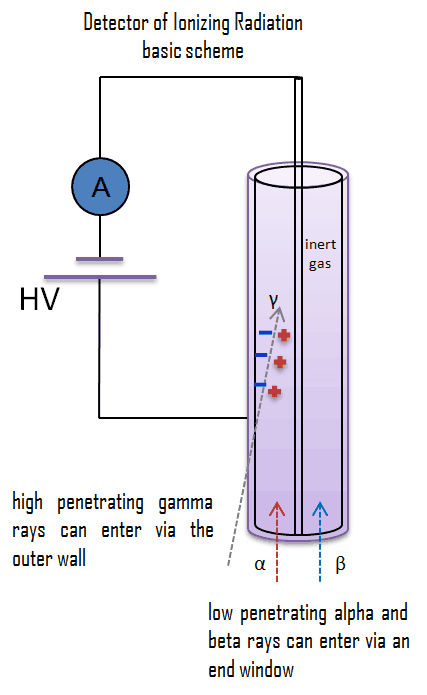
The Geiger counter, also known as the Geiger-Mueller counter, is an electrical device that detects various types of ionizing radiation. This device is named after the two physicists who invented the counter in 1928, and Mueller was a student of Hans Geiger. Geiger counter is widely used in applications such as radiation dosimetry, radiological protection, experimental physics, and the nuclear industry. A Geiger counter consists of a Geiger-Müller tube (the sensing element which detects the radiation) and the processing electronics, which displays the result.
Geiger counter can detect ionizing radiation such as alpha and beta particles, neutrons, and gamma rays using the ionization effect produced in a Geiger–Müller tube, which gives its name to the instrument. The voltage of the detector is adjusted so that the conditions correspond to the Geiger-Mueller region.
Basic Principle of Geiger Counters

The Geiger counter has a cathode and an anode held at high voltage, and the device is characterized by a capacitance determined by the electrodes’ geometry. In a Geiger counter, the fill gas of the chamber is an inert gas that is ionized by incident radiation and a quench gas of 5–10% of an organic vapor or a halogen gas to prevent spurious pulsing by quenching the electron avalanches.
As ionizing radiation enters the gas between the electrodes, a finite number of ion pairs are formed. The average energy needed to produce an ion in the air is about 34 eV. Therefore a 1 MeV radiation completely absorbed in the detector produces about 3 x 104 pairs of ions. The behavior of the resultant ion pairs is affected by the potential gradient of the gas’s electric field and the fill gas’s type and pressure. Under the influence of the electric field, the positive ions will move toward the negatively charged electrode (outer cylinder), and the negative ions (electrons) will migrate toward the positive electrode (central wire). The electric field in this region keeps the ions from recombining with the electrons. Near the anode wire, the field strength becomes large enough to produce Townsend avalanches. These avalanches can be triggered and propagated by photons emitted by atoms excited in the original avalanche. Since these photons are not affected by the electric field, they may interact far (e.g., laterally to the axis) from the primary avalanche, and the entire Geiger tube participates in the process. A strong signal (the amplification factor can reach about 1010) is produced by these avalanches with shape and height independently of the primary ionization and the energy of the detected photon. The high amplification factor of the Geiger counter is the major advantage over the ionization chamber. The Geiger counter is a much more sensitive device than other chambers. It is often used to detect low-level gamma rays and beta particles for this reason.
Since the positive ions do not move far from the avalanche region, a positively charged ion cloud disturbs the electric field and terminates the avalanche process. In practice, the avalanche’s termination is improved by using “quenching” techniques.
Collecting all these electrons will produce a charge on the electrodes and an electrical pulse across the detection circuit. Each pulse corresponds to one gamma-ray or neutron interaction, and the pulse height is not proportional to the number of original electrons produced. Therefore, Geiger counters are incapable of particle identification and energy measurement (spectroscopy). Since the process of charge amplification greatly improves the detector’s signal-to-noise ratio, subsequent electronic amplification is usually not required.